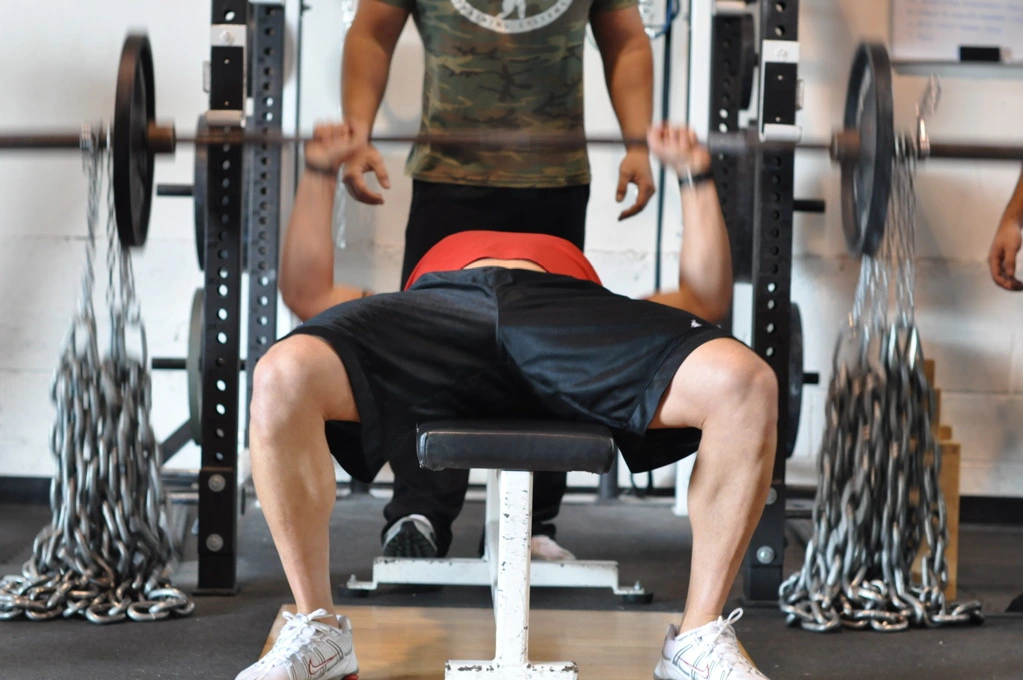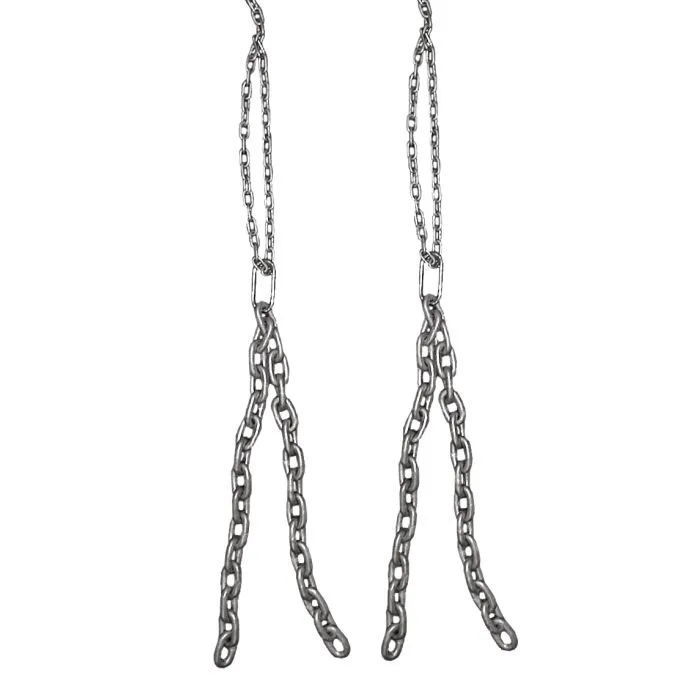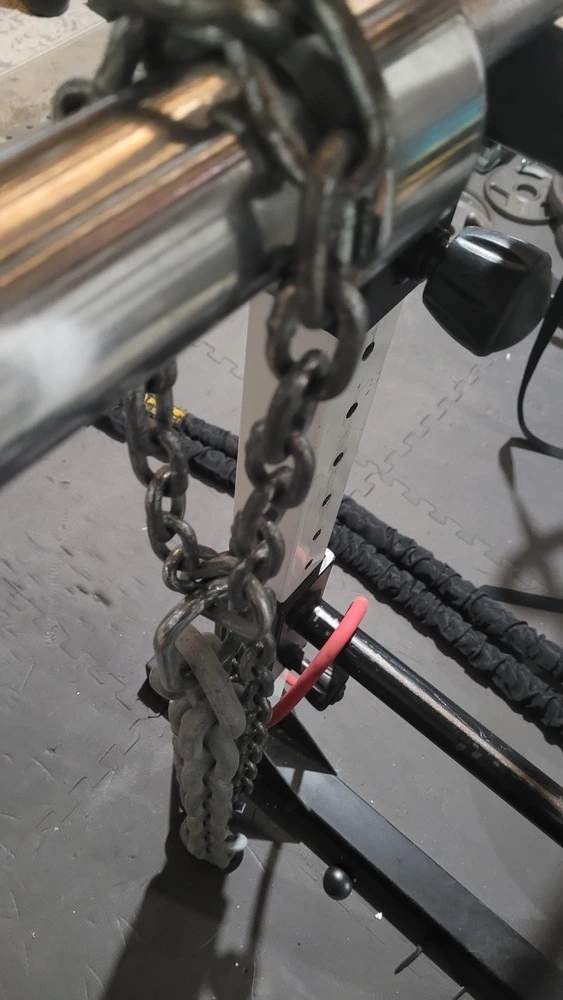If you’re looking to take your bench press up a notch – and aren’t we all? – adding chains is a great way to do it. A bench press with chains offers variable resistance throughout the entire range of motion, which can help you build more strength and muscle. But there are couple things to be aware of before jumping in to pressing with chains.

So in this blog post, I’ll discuss how to use chains in your bench press and the benefits they offer. I’ll also look at some studies that support using chains in this (and other) exercise. So if you’re looking for a new way to supercharge your bench press, read on!
Bench Press With Chains - A Quick Overview: - Benching with chains allow you to mimic your body’s natural strength curve. - Chains are a tool and not for everyone. Beginners should stick with basics. - There are drawbacks - noise, expense, size - to be aware of. - Some of the world's strongest lifters use chains for a myriad of exercises. - Scientific studies have proven out certain benefits when using chains.
What are chains and what do they do?
First popularized by powerlifter Louie Simmons of the famed Westside Barbell gym, chains – and their cousin bands – have been used to get already strong people, well, stronger. In fact, chains have been used in powerlifting for decades now.
But if you ask the average gym goer, they’ve most likely never heard let alone seen lifting chains. And that begs the question: why even use chains in the first place? I mean, if you’re looking to add weight to a lift why not – I don’t know – just add some extra weight? Aren’t you just unnecessarily complicating something simple?
Well, let’s take a look…
Some Background
Before we delve into a few of the advantages of chains, we need to talk about a component of strength training called the strength curve. While you’ll fine some different definitions, here’s the one I like best: the strength curve is is the difficulty of an exercise throughout the range of motion of that exercise.
That should intuitively make sense if you’ve lifted as you’ve probably experienced a “sticking point” – that one point where you just can’t lift the weight without assistance. While it’s a simple concept, in practice it’s a bit more complicated as different exercises have different curves.

For example, some exercises like the bench press and squat have an ascending strength curve where the exercise feels easier the closer you are to full flexion(or lock out). For a bench, that’s when the bar is furthest away from your chest. For a squat, that’s at the top of the movement when your legs are almost completely straight.
Other exercises have a descending strength curve where it’s hardest at flexion; a ring row or a pull-up are great examples. And yet other exercises exhibit a bell-shaped curve, where the exercise is easiest at the top and bottom ranges of motion. A simple dumbbell bicep curl is a great example as the curl is most difficult throughout the middle portion of the lift.
Benefits of chains
So now that we know different exercises have different curves, let’s look at the original question: why you should use chains instead of just adding more weight?

As you probably figured out, chains allow you to mimic your body’s natural strength curve (also called the force velocity curve). In other words, chains provide what’s called accommodating resistance. For those unfamiliar with the term, accommodating resistance basically means that the load changes during the lift to accommodate to your natural strength.
Or, as Dr. Aaron Horschig put it in his fantastic book Rebuilding Milo, “chains effectively accommodates for the body’s natural force velocity curve during the lift. This method can help athletes improve their bar speed and power through the sticking points of the ascent.”
Let’s take the bench press example again. With a bench, you’re typically weakest when the bar is at or near your chest and strongest when the bar is almost at lock out. If you just add more weight, eventually you reach a a sticking point where you can’t lift the bar any higher (without help). Once helped, typically, you’re able to finish the lift yourself.
Now, instead of adding plates we add chains. As you lower the bar, more chain goes onto the floor and the bench press gets lighter the lower you go. At the bar’s lowest point – at your chest – the weight is the lightest. That corresponds with your weakest point. Which means you can now fight through that sticking point on your own.
This is a big advantage as the best way to get strong is through the concept of progressive overload. Progressive overload is when you gradually increase the weight, frequency, or volume of your strength training routine. Essentially, you’re now able to lift a weight that you previously could not. And that’s how you continue to develop strength.

One quick note, resistance bands allow you to do something similar although there are some pretty significant differences. Maybe I’ll cover those in a future in article.
Anyways, in addition to allowing you to work past your sticking points, there are a couple other advantages people experience when using chains:
- Speed training. Speed training is exactly what it sounds like – you’re focusing on power and explosion (or generating more force) instead of just weight. Chains are an effective tool for speed training because the accommodating resistance teaches you to push as hard as you can throughout the entire lift.
- Stability. When properly set, chains will swing some during an exercise. That forces you, the lifter, to stabilize and control the weight more than you would in normal lift.
Drawbacks of chains
Now that we’ve covered the benefits, I should note it’s not all rainbows and sunshine in chain-land as there are some drawbacks. In my mind, there are 4 major ones:
- Noisy. Depending on your gym, that may or may not be a big deal but just be aware.
- Fairly expensive. If you’re trying to save money or can’t deal with the noise, you might want to look at some resistance bands instead of a heavy chain.
- Limited Use. Yes, you can use them for deadlifts, squats, and other exercises but they’re still not as versatile as other equipment such as adjustable dumbbells or bands.
- Unnecessary for a lot of people. I’ll discuss this immediately below but be sure you can actually benefit from chains before you buy them. Otherwise, you’re going to end up with a big (and expensive) paperweight.
So who should use chains?
Now that you know why you should use chains (and the drawbacks) when bench pressing, the question becomes: should you? And, much like the smell at an old folk’s home….Depends 1yeah, that was bad. For the beginner or average lifter, there’s really no need to chains. You should be able to make progress just by simply being consistent and sticking to the basics.

For the intermediate to advanced lifter who has hit a stumbling block, then chains become a valuable tool to add extra resistance, get past your weak points, and improve your strength and power. Here’s a general guideline I grabbed from elitefts although I made a couple adjustments:
- For a 250 bencher, use one set of chains
- 300 – one to two sets of chains
- 350 – two to three sets
- 400 – three or more chains
So if not able to bench 200+ pounds or your bodyweight, you’re most likely not ready for chains. Stick with the basics and work on getting stronger first. Then, you can look at adding some chain weight (each chain is 20 lbs. so the two would add 40 lbs. total) into your training regimen.
How to bench press with chains
Now that you know the why and the who of a bench press with chains, let’s look at the how. Here’s a guide on how to setup your chains, with some pics that I took of my setup for reference.
First, normal heavy chains are going to weigh in at 20 lbs. per chain, or 40 lbs. total weight. The chain link size is usually 5/8″ with a length of about 5′ long. While there are other heavy chain options, that’s typically what you’re going to find. And while you can find some on Amazon, I bought mine from Elite Fitness many years ago.
Now, let’s look at how you attach the chains to the bar. Typically for a bench press, you’ll need a smaller chain in order to attach the larger chain. This “holding chain” will be attached to the bar and the larger chain (via one the chain links) will be attached to that via a carabiner. Those chains will weigh about 10 lbs. on average for a total of 50 lbs. for an entire set of chains.

In combination, the two chains allow you to set the chain weight properly so that some of the larger chain is lightly touching the ground. You can have it completely off the ground but just be prepared to deal with a lot of excess movement from the swinging chain weight. Because of that, I like to have some of the chain links touching the ground even at lockout.

Now, should you set the chains first or add weight and then add the chains? Well, I’ve seen both. Personally, I like adding my weight plates to the desired weight and then adding chains. But you can absolutely set the chains first and then add plates. Either way works. Just be sure to secure everything with clips.

Now that everything is set, you’re ready to bench press like normal. While it may feel odd at first – remember, the chains will cause some additional movement at the top part – just focus on good technique and exploding upward at the bottom of the movement. That forceful drive will help you lift the chains off the ground and complete the lift.
Scientific studies about using chains
Lastly, I want to take a look at a couple studies that evaluated using a chain during training. The first study is called The Acute Effects of Attaching Chains to the Barbell on Kinematics and Muscle Activation in Bench Press in Resistance-Trained Men and its aim was “to investigate the acute effects of attaching chains on barbell kinematics and muscle activation in the bench press.” Kinematics is the the branch of mechanics concerned with the motion of objects without reference to the forces which cause the motion.
Anyways, you can ready the study here (it’s long) but one of the best excerpts is listed below:
To the best of our knowledge, only two studies have examined upper body exercises [19,20]. Baker and Newton [19] investigated the effect of chains on barbell kinematics and found that the use of chains with an equivalent of about 15% of 1-RM attached to a barbell at 60% of 1-RM allowed the athletes to generate 10% greater velocities as compared to a conventional barbell load at 75% of 1-RM during the bench press. Godwin et al. [20] compared bench press throws at 45% of 1-RM using either a constant load or a constant load (30% of 1-RM) + chains (15% of 1-RM) in rugby players. The findings showed greater barbell acceleration and velocity for the chain condition.

Another study I found looked at training the deadlift with chains. That study, Kinematic and kinetic analysis of maximal velocity deadlifts performed with and without the inclusion of chain resistance, set out to determine “whether the inclusion of chains enhanced the suitability of the deadlift for ERT (Explosive Resistance Training).”
They then tested subjects at various levels of their Max weight and then included chains at the Max level. The researchers summarized their findings as such:
Compared to using a constant resistance, the inclusion of chains enabled greater force to be maintained to the end of the concentric action and significantly increased peak force and impulse (p < 0.05), while concurrently decreasing velocity, power, and rate of force development (p < 0.05). …The results of the investigation suggest that the deadlift can be incorporated effectively in ERT programs.
Remember, this was at the subjects’ 1RM. In essence, it allowed them to lift more weight but in doing so it took them longer. That makes sense as the closer to your max you lift, the slower you must go. The important thing is that it allowed subjects to “significantly” increase their force. One last outtake that sums it up well:
This study was the first to test the theory that the inclusion of chains with a traditional resistance exercise enables greater force production to be maintained during the latter stages of the concentric action. The results confirmed the theory and illustrated that larger relative forces were maintained when heavier chains were included.
In Summary (TL;DR)
If you’re at a sticking point with your bench press strength and power and you’re no longer a beginner, you should consider a doing a bench press with chains. They’re easy to find, easy to apply, and do a great job with providing accommodating resistance.
While there are some drawbacks and they’re not necessary to get strong, they are a great tool. And, as shown above, scientists have confirmed their validity in weight training. And, beyond that, many of the world’s strongest lifters (and best trainers) have used them to push themselves, get stronger muscles, and set new personal records (PRs). If you’re on the fence and have the means, go ahead and give them a try.








